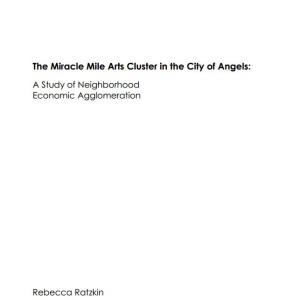
Authors: Rebecca Ratzkin
Date: January 1, 2005
Project: [wpv-post-link id=”$project”]
Cluster economies establish criteria in which to examine an industry, its mechanism of production, its effect on the city’s economy, and its potential for sustainability in an unknown future. Clusters can be defined by a geographic concentration of firms and institutions of a particular industry, the subsequent consumer efficiency achieved from the geographic concentration, an interconnectedness between firms, buyers and suppliers and clients and firms, and the potential to generate collective action in the production of goods and services (Porter 1998). This study uses these conditions as a basis for examining a group of galleries and museums in the Miracle Mile neighborhood of Los Angeles in order to establish the existence of an arts cluster economy. The study finds a significant concentration of art facilities in the Miracle Mile neighborhood with location quotients for both galleries and museums substantiating data regarding the increasing number of establishments. A survey of visitors corroborated that consumers experience greater utility in attending art facilities in the Miracle Mile, and interviews with galleries and vendors, as well as informal conversation with museum representatives, revealed interactions between businesses as well as the presence of collective action. However, barriers to collective action, such as heterogeneity of firms, inhibit the Miracle Mile
cluster from achieving optimal production of collective action, suggesting the possibility of public intervention such as the implementation of specific community plans, public signage programs and outside agents to increase the effectiveness of the arts cluster economy.